Uncategorized
The treasures discovered by a group of non-Jews in Lublin
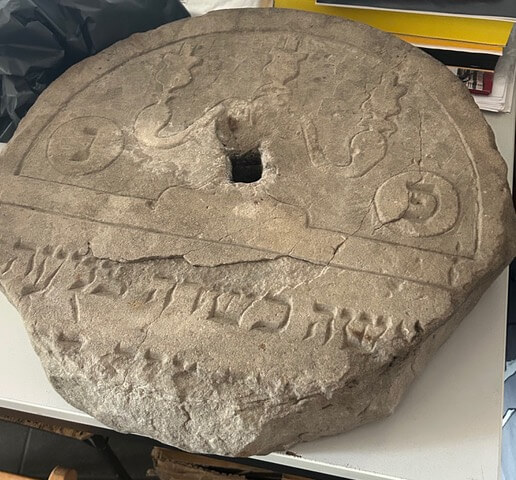
דער פּאָעט יעקבֿ גלאַטשטיין, אַ געבוירענער אין לובלין, פּוילן, האָט געשריבן:
לובלין, מײַן הייליקע ייִדישע שטאָט, שטאָט פֿון גרויסן דלות און פֿריילעכע ייִדישע יום־טובֿים…
שטאָט פֿון אויפֿגעוואַכטן קלאַסנקאַמף. . . .
לובלין, מײַן הייליקע ייִדישע שטאָט פֿון בילדונג־דאָרשטיקע יונגע־לײַט און יונגע מיידלעך, פֿון דעם ערשטן בעז־אַראָמאַט פֿון יונג־העברעיִש און פֿון דער באַטעמטקייט פֿון שטאָלצן ייִדיש.
הייליקע שטאָט מײַנע, . . . ווער וועט דיך צוריקשטעלן און צוריקבויען, מײַן הייליקע שטאָט, אַז פֿאַרוויסט ביסטו געוואָרן ביז דײַנע פֿונדאַמענטן און ביסט איין מוראדיקע מצבֿה.
מע שלאָגט שינדלען, מע לייגט דעכער, מען פֿאַרריכט און מען פֿאַרניצעוועט אַן אַלטע פּאַסקודנע וועלט, אָבער מײַן הייליקע שטאָט, די שטאָט פֿון מײַן וועלט, וועט קיין מאָל נישט צוריקגעבויט ווערן.
גלאַטשטיין איז געווען גערעכט. זײַן הייליקע שטאָט לובלין, די שטאָט פֿון אַרום 43,000 ייִדן פֿאַר דעם חורבן, כּמעט אַ דריטל פֿון דער דעמאָלטיקער באַפֿעלקערונג, וועט קיין מאָל נישט צוריקגעבויט ווערן, אָבער עס זײַנען דאָ מענטשן און אַן אָרגאַניזאַציע, דווקא נישט קיין ייִדן און נישט קיין ייִדישע, וואָס אַרבעטן כּדי אויפֿצוהאַלטן דעם אָנדענק פֿון יענער הייליקער ייִדישער שטאָט. די אָרגאַניזאַציע הייסט „בראַמאַ גראָדסקאַ”, (דער שטאָטטויער) און עס געפֿינט זיך אין אַ בנין אין דעם טויער, וואָס ייִדן פֿלעגן רופֿן „גראָדסקע בראָם“ אָדער „ברום“, דורך וועלכן מע פֿלעגט אַרײַנגיין אין דער אַמאָליקער ייִדישע געגנט.
דעם זומער, זײַענדיק אין פּוילן האָבן מיר (מײַן מאַן, אונדזער עלטערע טאָכטער בענאַ און איך) געמאַכט אַן עקסקורסיע קיין לובלין, — די שטאָט וווּ מײַן טאַטע האָט געוווינט ווי אַ צענערלינג ביז 1927, די שטאָט פֿון זײַן אַרײַנטריט אין „אויפֿגעוואַכטן קלאַסן־קאַמף“ און „שטאָלצן ייִדיש“,— און זיך געטראָפֿן מיט פּיאָטער נאַזאַרוקן, אַ געוועזענער ייִדיש־סטודענט פֿון דער ווײַנרײַך־פּראָגראַם בײַם ייִוואָ. פּיאָטער האָט אונדז אַרומגעפֿירט איבער דער שטאָט און דערציילט וועגן דער געשיכטע און אַרבעט פֿון דער אָרגאַניזאַציע.
„בראַמאַ“ האָט זיך אָנגעהויבן אין 1990 ווי אַ טעאַטער־טרופּע אָבער מיט דער צײַט האָבן די באַטייליקטע אײַנגעזען אַז זיי געפֿינען זיך אין האַרץ פֿון עפּעס אַ סך מער דראַמאַטישס ווי די דראַמאַטישיסטע פּיעסע — דער פֿאַרלוירענער ייִדישער וועלט — און זיי האָבן אָנגעווענדט זייערע כּוחות און פֿעיִקייטן אויף רעקאָנסטרוּירן און אויפֿהיטן די געשיכטע פֿון יענער וועלט.
שטעלט זיך די פֿראַגע, פֿאַר וואָס וואָלטן נישט־ייִדן זיך אָפּגעגעבן מיט אויפֿהיטן דעם אָנדערק פֿון די ייִדן? און די פֿראַגע קומט טאַקע דעם גאַסט אַנטקעגן ווען מע טרעט אַרײַן אינעם בנין. אויף דער וואַנט הענגט אַן אויפֿשריפֿט אין דרײַ שפּראַכן: פּויליש, ענגליש און עבריתּ בזה הלשון: „ייִדן וואָס קומען אַהער פֿרעגן אונדז, איר זײַט דאָך נישט קיין ייִדן. איר זײַט פּאָליאַקן און די ייִדישע שטאָט איז ניט אײַער געשיכטע. פּאָליאַקן פֿרעגן אונדז, ,פֿאַר וואָס טוט איר דאָס, איר זײַט דאָך פּאָלאַקן און די ייִדישע שטאָט איז ניט אײַער געשיכטע. אָדער אפֿשר זײַט איר טאַקע ייִדן?
„געדולדיק גיבן מיר צו פֿאַרשטיין אַז דאָס איז אונדזער בשותּפֿותדיקע פּויליש־ייִדישע געשיכטע. צו געדענקען די אויסגעהרגעטע ייִדן דאַרף מען נישט זײַן קיין ייִד.“
אויף אַן אַנדער וואַנטשילד שטייט געשריבן: „עס איז דאָ, בײַם גראָדסקע־טויער, וואָס מע רופֿט אויך ׳דער ייִדישער טויער׳, וואָס איז דער שומר איבער דעם נישט־עקסיסטירנדיקן שטעטל — דעם ייִדישן אַטלאַנטיס — וווּ מיר באַמיִען זיך צו פֿאַרשטיין דעם באַטײַט און דעם שליחות פֿון דעם אָרט הײַנט.“
עס זײַנען דאָ פֿאַרשיידענע אופֿנים און פּראָיעקטן דורך וועלכע זיי טוען דאָס. איינער אַזאַ האָט צו טאָן מיט פֿאָטאָגראַפֿיעס. אין 2015 האָט בראַמאַ גראַדסקאַ באַקומען אַן אוצר, אַ זאַמלונג גלעזערנע נעגאַטיוון (glass plate negatives, בלע״ז) וואָס אַרבעטערס האָבן צופֿעליק געפֿונען אין אַ בוידעם אויף רינעק 4. דער פֿאָרשער יעקבֿ כמיעלעווסקי אין מײַדאַנעק האָט אַנטדעקט אַ מעגלעכע פֿאַרבינדונג צווישן דעם אַדרעס און אַ פֿאָטאָגראַף, אַבראַם זילבערבערג, וואָס האָט דאָרטן אַ שטיק צײַט געוווינט.
די זאַמלונג איז כּולל מער ווי 2,700 גלעזערנע נעגאַטיוון פֿון פֿאַרשיידענע גרייסן, פֿון בילדער גענומען צווישן 1914 און 1939. ניט געקוקט אויף די 75 יאָר, די נישט־גינסטיקע באַדינגונגען אין בוידעם — די קעלט ווינטערצײַט און די היצן זומערצײַט — האָבן ס׳רובֿ פֿון די נעגאַטיוון זיך אויפֿגעהיט. זיי געבן דעם צוקוקער אַ בליק אַרײַן אין דעם וואָס זיי רופֿן „אַ נישט־עקסיסטירנדיקע שטאָט“: בילדער פֿון קינדער און דערוואַקסענע, מענער און פֿרויען, פֿרומע און וועלטלעכע, ייִדן און נישט־ייִדן, פֿאַרשיידענע פֿאַכלײַט, יחידים און גרופּעס, יוגנט־באַוועגונגען און ספּאָרטקלובן.
אַנדערע בילדער פֿון חתונות, בריתן און מצבֿות דאָקומענטירן וויכטיקע מאָמענטן אין דעם ייִדישן משפּחה־לעבן. די פֿאָטאָגראַפֿיעס שפּיגלען אויך אָפּ דעם בהדרגהדיקן איבערגאַנג פֿון אַ פֿרום, טראַדיציאָנעל לעבן צו אַ מער וועלטלעכן. דאָס רובֿ זײַנען בילדער פֿון פּשוטע לײַט, אין גאַנג פֿון דער טאָג־טעגלעכקייט — מענטשן וואָס האָבן קיין מאָל נישט געמיינט אַז זיי וועלן ווערן שטומע עדות אויף אַ פֿאַרשוווּנדענער וועלט.
אַן אַנדער פּראָיעקט האָט צו טאָן מיט דער דיגיטאַלער ביבליאָטעק פֿון דער ישיבֿת חכמי לובלין, אַ וויכטיקער מקום־תּורה וואָס האָט זיך געעפֿנט אין לובלין אין 1930, און איז געווען רעוואָלוציאָנער אין דער ישיבֿה־וועלט, נישט נאָר פֿאַר דעם דף־יומי וואָס איר פֿאַרלייגער, ר’ מאיר שאַפּיראָ, האָט אײַנגעפֿירט אויף אַ קאָנפֿערענץ פֿון אַגודת־ישׂראל אין ווין אין 1923, נאָר אויך פֿאַר איר שיינעם בנין וואָס האָט געהאַט אַן עסזאַל און אינטערנאַטן פֿאַר די בחורים, אַ סגולה צו די שוועריקייטן פֿון דינגען אַ צימער און עסן טעג אין פֿרעמדע הײַזער.
במשך פֿון די קנאַפּע צען יאָר פֿון איר עקסיסטענץ, פֿון 1930־1939, האָט די ישיבֿה אָנגעזאַמלט אַ ביבליאָטעק פֿון צענדליקער טויזנט ספֿרים, ביכער און צײַטשריפֿטן. אין 1941 האָבן די נאַציס אײַנגענומען לובלין און ביז מיט אַ יאָרצענדליק צוריק האָט מען געמיינט אַז נאָר פֿינעף ביכער האָבן זיך געראַטעוועט. אָבער אַ דאַנק דער איבערגעגעבענער אַרבעט פֿון בראַמאַ גראָדסקאַ, אונטער דער אָנפֿירערשאַפֿט פֿון פּיאָטער נאַזאַרוק און מאָניקאַ טאַרײַקאָ, האָבן זיך שוין אָפּגעזוכט ביז הײַנט 1,555 ביכער, פֿונאַנדערגעשפּרייט אין ביבליאָטעקן איבער דער גאָרער וועלט.
בראַמאַ גראָדסקאַ ווייסט אַז ס׳איז נישטאָ קיין שׂכל אין צוריקברענגען די ביכער קיין לובלין, אַ שטאָט וואָס האָט קוים אַ מנין ייִדן. דערפֿאַר צילעווען זיי מיט זייער דיגיטאַלער ביבליאָטעק אויסצוזוכן, אידענטיפֿיצירן און קאַטאַלאָגירן אַלע ביכער מיט שטעמפּלען פֿון דער ישיבֿה. אַזוי האָפֿן זיי צו רעסטאַוורירן די זאַמלונג און זי כאָטש סימבאָליש צוריקקערן קיין לובלין.
אַזוי ווי בראַמאַ גראָדסקאַ דינט ווי דער אַדרעס פֿאַר אויפֿהיטן דעם אָנדענק פֿון די ייִדן אין לובלין קען מען דאָרטן געפֿינען אויסטערלישע זאַכן וואָס מענטשן האָבן צופֿעליק געפֿונען און אַהין אַרײַנגעגעבראַכט: למשל, אַ וואָגנראָד וואָס האָט זיך ערגעץ געוואַלגערט, געמאַכט פֿון אַ ייִדישער מצבֿה, אַן עדות אויף אַנטיסעמיטישן וואַנדאַליזם.
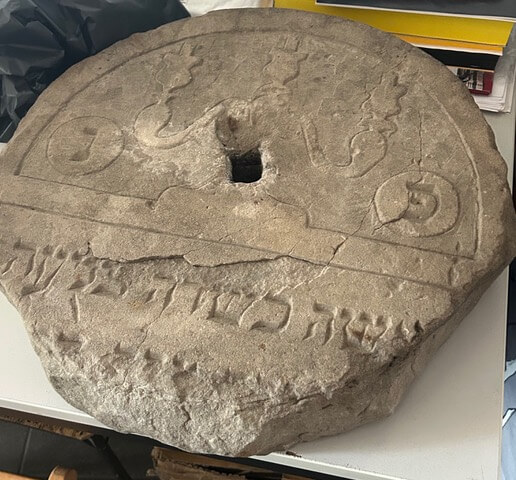
בראַמאַ פֿירט אויך אָן מיט דערציִערישע פּראָגראַמען וועגן דעם חורבן און דעם ייִדישן לעבן פֿאַר דעם חורבן פֿאַר לערערס פֿון פּוילן און פֿון אויסלאַנד. זיי האָבן אַ דאַטן־באַזע וווּ זיי זאַמלען אינפֿאָרמאַציע וועגן געוועזענע לובלינער פֿון פֿאַרשיידענע מקורים, ווי למשל, רשימות פֿון אײַנוווינערס פֿון בנינים און שטים־רשימות.
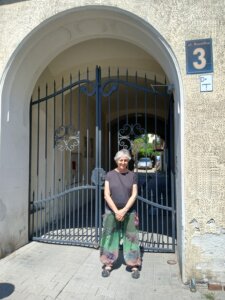
איך האָב, פֿאַרשטייט זיך, געבעטן בײַ פּיאָטערן ער זאָל זוכן אינפֿאָרמאַציע וועגן מײַנע אייגענע אָבֿות, דער משפּחה צוקער. האָט ער געזוכט אונטער זייער אַדרעס, רוסאַלקע 3, וווּ ער האָט אונדז פֿריִער געהאַט געפֿירט. צווישן די אַלע נעמען פֿון די אײַנוווינערס פֿון בנין וואָס האָבן זיך געפֿונען אין דער דאַטן־באַזע, בתוכם נישט קיין איין צוקער (מסתּמא ווײַל די משפּחה איז שוין געהאַט אַוועק פֿון לובלין אין די סוף צוואַנציקער יאָרן) האָט איין נאָמען מיר פֿאַרכאַפּט דעם אָטעם: מאָשעק (משה) גאָטליב, פֿון פֿאַך אַ בראַקער.
איך האָב קיין מאָל נישט געטראָפֿן משה גאָטליבן. געוווּסט האָב איך נאָר אַז ער איז געווען דער ערטשער מאַן פֿון דעם טאַטנס עלטסטער שוועסטער לובע און אַז זיי האָבן נאָך אַ פּאָר יאָר זיך געגט. כאָטש די מומע לובע איז שוין געווען אַ בונדיסטקע האָט זי מסכּים געווען צו אַ שידוך (איך ווייס ניט צי פֿרײַוויליק צי נישט) מיטן זון פֿון איינעם אַ גאָטליב מיט וועמען דער טאַטע (מײַן זיידע), אויך אַ בראַקער, האָט געהאַט געשעפֿטן.
מיר איז דאָס אַלע מאָל געווען אַזאַ אינטערעסאַנטער באַווײַז פֿון דעם וואָס ווי די אַלטע וועלט און די נײַע זײַנען דעמאָלט געווען געקניפּט און געבונדן. נאָך אַלעמען, ווי קומט אַ בונדיסטקע צו אַ שידוך?! מער ווי דאָס האָב איך וועגן משה גאָטליבן נישט געוווּסט. ס׳איז מיר קיין מאָל אַפֿילו נישט אײַנגעפֿאַלן צו פֿרעגן אויב ער איז אומגעקומען אָדער האָט איבערגעלעבט דעם חורבן; בײַ מיר האָט זײַן שייכות צו מײַן משפּחה זיך געענדיקט מיטן גט ערגעץ אין די 20ער יאָרן. נאָר ס׳איז קלאָר אַז ער איז אומגעקומען.
איך האָב געקענט זייער זון איצוש ע״ה, וואָס האָט אין די 1950ער יאָרן עמיגרירט קיין קאַנאַדע, וווּ מיר האָבן געוווינט, נאָר ס׳איז מיר אויך קיין מאָל נישט אײַנגעפֿאַלן אים צו פֿרעגן וואָס איז געשען מיטן טאַטן זײַנעם. צי האָט ער נאָך אַ מאָל חתונה געהאַט, האָט ער געהאַט אַנדערע קינדער — האַלבע־ברידער אָדער ־שוועסטער? זײַנען זיי אויך אומגעקומען?
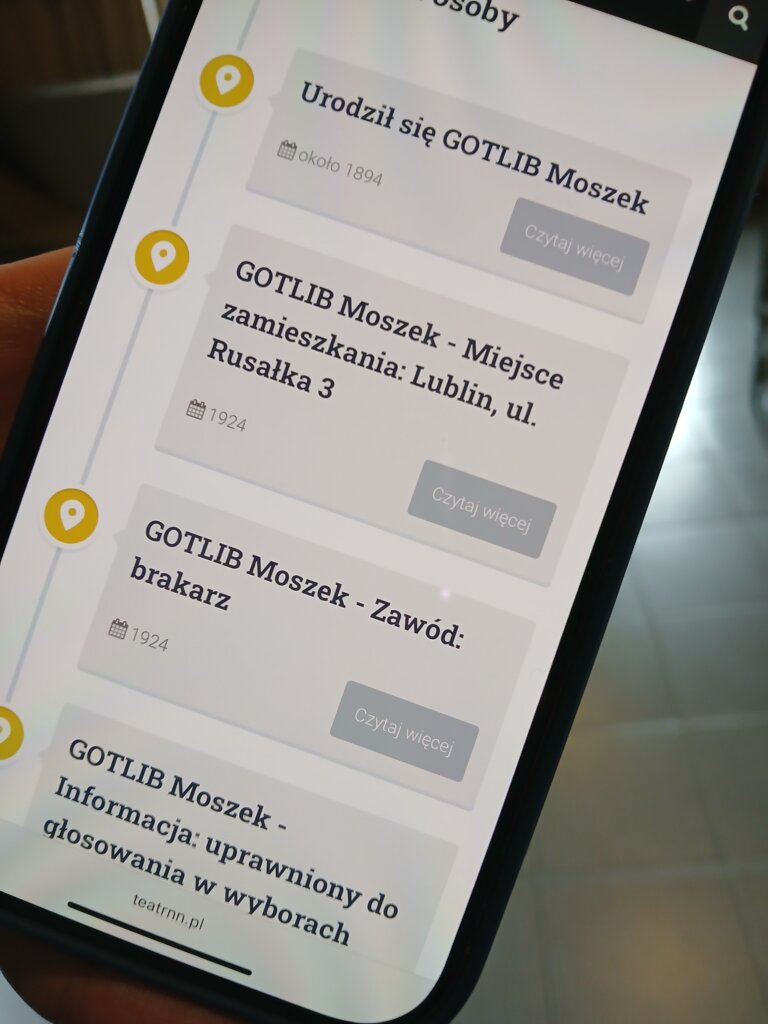
מסתּמא וועל איך קיין מאָל נישט האָבן קיין ענטפֿער אויף די פֿראַגעס אָבער די קנאַפּע ידיעות האָבן אויפֿגעלעבט פֿאַר מיר אויף אַ פּאָר מינוט אַ מענטשן. דאָס איז טאַקע דער ציל פֿון בראַמאַ גראָדסקאַ — צו ווײַזן אַז די אומגעקומענע זײַנען נישט געווען בלויז ציפֿערן. דאָס ביסל אינפֿאָרמאַציע וועגן משה גאָטליבן איז אַרײַן אין איינער פֿון די 43,000 פּאַפּקעס — איין פּאַפּקע פֿאַר יעדן אומגעקומענעם ייִד, וואָס האָט געוווינט אין לובלין ערבֿ דעם אויסבראָך פֿון דער מלחמה.
און דווקא יענע דינע פּאַפּקעס האָבן מער פֿון אַלע פּראָיעקטן און חפֿצים, געמאַכט אויף מיר דעם גרעסטן אײַנדרוק. בראַמאַ צילעוועט צו געפֿינען עפּעס אַ ידיעה וועגן יעדן פֿון די 43,000 קדושים. עס קען זײַן אַ נאָמען, אַן אַדרעס, אַ פֿאַך, אַ געבוירן־טאָג, עפּעס וואָס ראַטעוועט דעם נאָמען פֿון אַנאָנימקייט און אָטעמט אַרײַן אין אים אַ נשמה.
וועגן 35,000 פֿון די אַמאָליקע אײַנוווינער האָט מען שוין עפּעס אַנטדעקט. געבליבן זײַנען נאָך 8,000 נשמות וואָס וואַרטן אויף אַ תּיקון.
The post The treasures discovered by a group of non-Jews in Lublin appeared first on The Forward.
Uncategorized
Jewish students report intimidation and closures as Oct. 7 anniversary sparks campus unrest
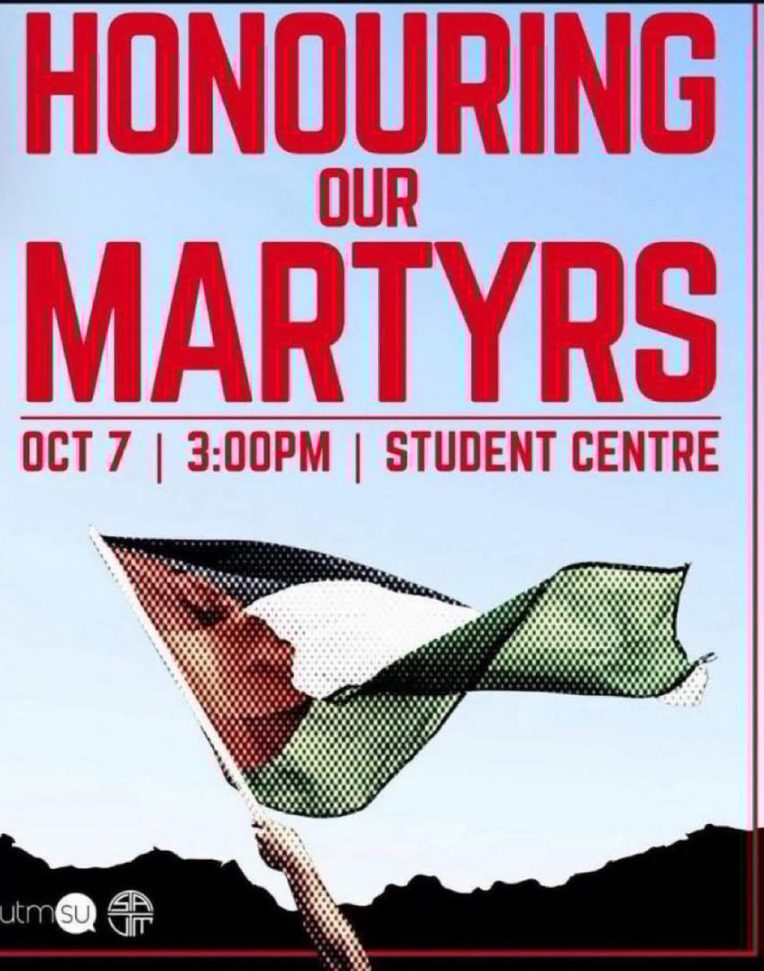
The second anniversary of the Oct. 7 Hamas-led terrorist attack on Israel was marked by vigils, protests and heated confrontations that Jewish students say left them feeling unprotected on their own campuses, while administrators issued statements about safety and free expression.
In Montreal, one university pre-emptively shut down its downtown campus. At the University of Toronto’s Mississauga campus, a vigil honouring Palestinian ‘martyrs’ ended with Jewish students being escorted out a back door. In Toronto, a high school’s decision to play O Canada in Arabic on Oct. 7 earned a rebuke from Ontario’s education minister.
StandWithUs Canada called Oct. 7 “a challenging day for Jewish and pro-Israel students,” saying many “fell victim to targeted harassment from antisemitic protesters” as they tried to mark the anniversary by displaying hostage photos and Israeli flags.
Montreal: Concordia closes, McGill sees flag burning and police warnings
In Montreal, Concordia University took the extraordinary step of closing its downtown Sir George Williams campus on Oct. 7, citing “the threat of extreme disruption.”
In a letter to students, vice-president and vice-chancellor Graham Carr said the decision was made “to protect our entire community” after two non-students were arrested the previous day—one allegedly carrying “a metal bar and several incendiary devices.”
“With hundreds of protesters from other universities and CEGEPs expected, as well as counter-protesters not linked to the university planning to gather outside our downtown campus this afternoon,” Carr wrote, “the threat of extreme disruption is simply too high to operate as usual. Acts of intimidation and violence have no place in our society.”
Concordia’s communications office had already reminded students that violence would not be tolerated and that those who wished to attend classes should be able to do so “without disruption or harassment.” But for many Jewish students, the shutdown felt like capitulation.
“It really scared many normal students who just want to go to class,” said Anastasia Zorchinsky, founder and co-president of the Startup Nation Concordia chapter. “It shows the university is giving in to the violence.”
Hundreds of officers—more than 600, according to Montreal police—patrolled the downtown core, sealing off sections of Ste-Catherine Street.
Outside Concordia’s Hall Building, about 80 counter-demonstrators, including Jewish Montrealers, Quebec nationalists and students from both Concordia and McGill, rallied in support of Israel before marching east toward McGill behind a billboard truck streaming images from the Oct. 7 massacre and other global atrocities.
At McGill University, which remained open but under restricted access, tensions escalated quickly. Several hundred pro-Palestinian demonstrators pushed through security gates to occupy the main lawn, setting off smoke bombs and ignoring police orders to disperse.
Zorchinsky who visited McGill, said she saw “fireworks in the middle of campus” and “a bloody Israeli flag” being burned on the ground. “It was just unbelievable and the police did nothing,” she told The CJN.
When a Jewish student unfurled an Israeli flag nearby, she said, police confronted him. “They said, ‘You’re going to get arrested if you don’t leave now,’” she recalled. “Then a few other students got their Israeli flags out and police came to us. They said it’s an order, you must leave now. We’re not negotiating.” Officers then physically escorted them off campus.
She described the experience as “unbelievable,” adding, “in that moment I understood that things are much worse than before.”
A Quebec Superior Court judge had denied McGill’s request weeks earlier for an injunction to restrict campus protests, finding that while evidence of antisemitic incidents was “extremely troubling,” the proposed order would not prevent future harm and could infringe on free expression.
McGill said it had “enhanced campus security measures” and that “academic activities will proceed as planned.”
Students such as Drew Sylver, who attends Concordia, said those promises rang hollow. “Statements are great, but action is what’s needed,” he told The CJN on Oct. 6. “Without visible consequences, the scene just repeats.”
Mississauga: Jewish vigil ends in confrontation
At the University of Toronto Mississauga (UTM), Jewish students gathered for a small vigil to commemorate victims of the Oct. 7 massacre. Hillel Ontario and StandWithUs Canada said the group was surrounded by demonstrators and escorted out a back door by security, calling it “a disgrace that, on the anniversary of the worst mass murder of Jews since the Shoah, Jewish students had to be escorted out a back door to protect them from an angry mob.”
The organizations described the event as “a moral failure and an institutional disgrace,” urging UTM to “immediately and unequivocally condemn this hateful mob and take action to hold those responsible accountable.”
The CJN reached out to the University of Toronto Mississauga for comment but did not receive a reply.

Toronto: anthem in Arabic on Oct. 7 prompts outrage
In Toronto, controversy erupted at Earl Haig Secondary School, where the morning broadcast of O Canada was played in Arabic. In an email statement, a Grade 12 student at Earl Haig told The CJN the anthem was followed by an announcement recognizing Islamic Heritage Month, and that the principal’s later message urging kindness made no mention of Jews, Israel or the Oct. 7 anniversary.
“Many students and parents felt this was incredibly insensitive,” the student wrote in an email statement. “Our administration has continued to ignore Jewish and Israeli voices—this being yet another example.”
StandWithUs Canada said the decision “begs questions at the very least about the school’s sensitivities, and at worst, about an intentional desire to isolate and discriminate against Jewish students.” The group described the timing—on the day marking “the deadliest attack on Jews since the Holocaust”—as “a coincidence too uncanny to ignore.”
Ontario Education Minister Paul Calandra criticized the move on X, writing that he was “disappointed that I would have to direct school boards [to] demonstrate appropriate respect for our National Anthem by ensuring that it is played only in its official form.” He said the incident “underscores that school boards should be focused on creating safe learning environments for all students, never at the expense of one community over another.”
Legal push: Tafsik files complaints over Oct. 7 incidents
Tafsik, a Jewish civil-rights organization that describes itself as a grassroots network combatting antisemitism and hate crimes in Canada, responded to the day’s events by announcing a wave of legal complaints to the Human Rights Tribunal of Ontario.
The filings name several institutions, including Earl Haig Secondary School, the University of Toronto, and multiple school boards and student unions.
“Yesterday was a brutal day for our community,” the organization said. “The horror of the October 7th massacre still hangs over us … but it wasn’t just the memory of that bloodshed that left us reeling. It was the sickening reality that once again, universities, schools, and unions chose to rally against us.”
Tafsik vowed to pursue accountability “with maximum intensity,” declaring that “Jewish safety and dignity are non-negotiable.” It also warned that individuals who incite hate or issue threats online would face “real, legal, expensive, and lasting consequences.”
Tafsik is on a rampage! Enough is enough!
Today our legal task force mobilized to go after institutions that mocked our community and celebrated October 7th massacre on campuses and schools across Ontario.
We have filed cases with the Human Rights Tribunal of Ontario against… pic.twitter.com/evTa0RVgBj
— Tafsik Organization (@Tafsikorg) October 8, 2025
‘Campus is unsafe’
By the end of the day, downtown Montreal remained under heavy police watch, and McGill’s lawns were littered with protest debris.
For Zorchinsky, who watched police push back Jewish students for displaying Israeli flags at McGill, the anniversary reinforced a grim pattern. “Campus is unsafe,” she said. “We all have to go there every single day, and the university itself should be changing that. Not us.”
She and others say they want more than symbolic gestures—they want consistent enforcement. “Without consequences, statements mean nothing,” Zorchinsky said.
With files from Joel Ceausu
The post Jewish students report intimidation and closures as Oct. 7 anniversary sparks campus unrest appeared first on The Canadian Jewish News.
Uncategorized
Minneapolis synagogue targeted with antisemitic, pro-Hamas graffiti on Oct. 7 anniversary
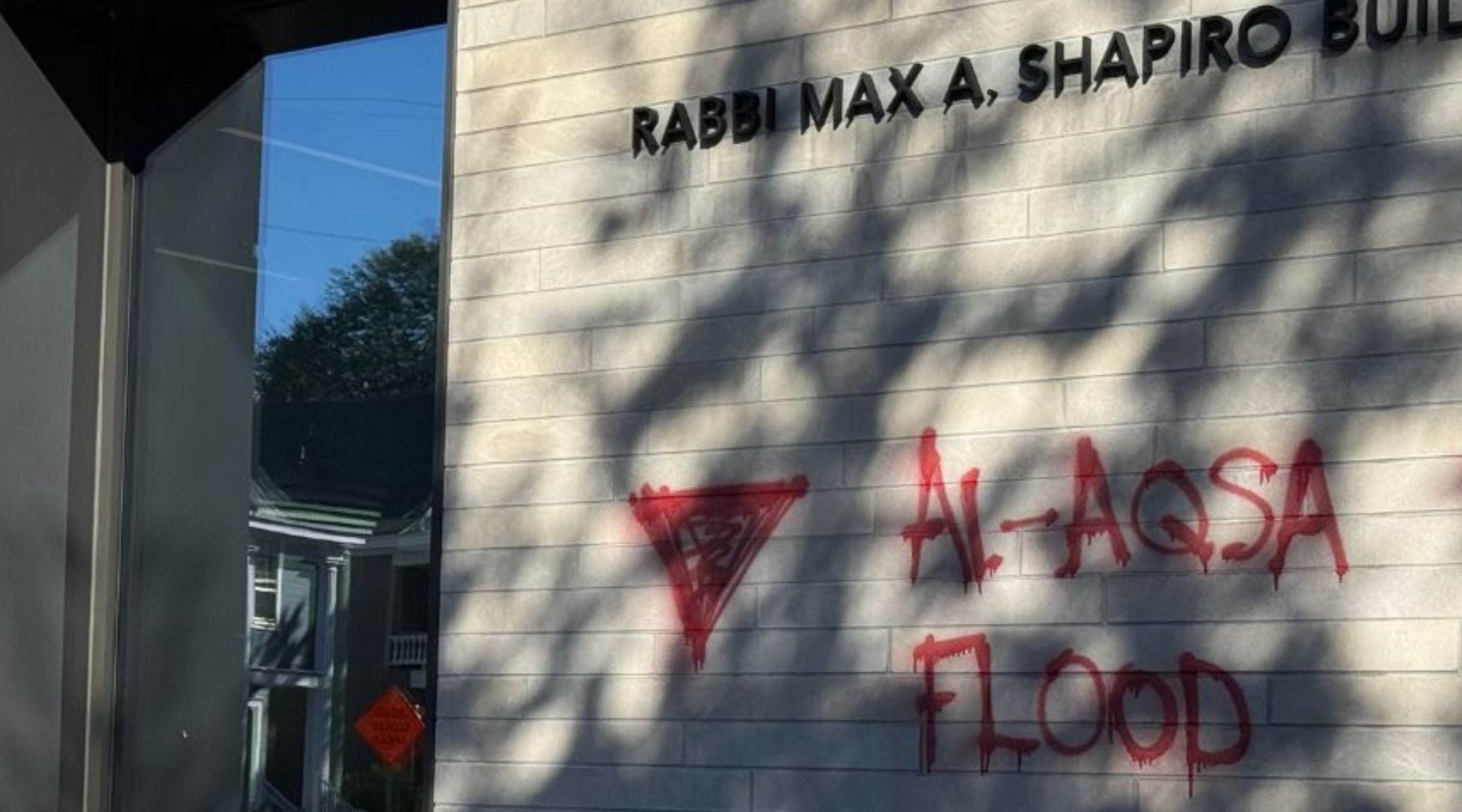
Graffiti targeting “zionists” and praising Hamas was spray-painted on the preschool wing of a Minneapolis synagogue on Tuesday night, the second anniversary of Hamas’ Oct. 7, 2023, attack on Israel.
Rabbi Marcia Zimmerman said she was notified by one of Temple Israel’s neighbors about the vandalism. She said her first reaction was outrage and pain.
“This does not solve any problem, and blaming American Jews in Minnesota for what’s happening globally is hate speech, it’s antisemitism. It’s nothing different than that,” she said. “It’s not about political differences. It’s about hate.”
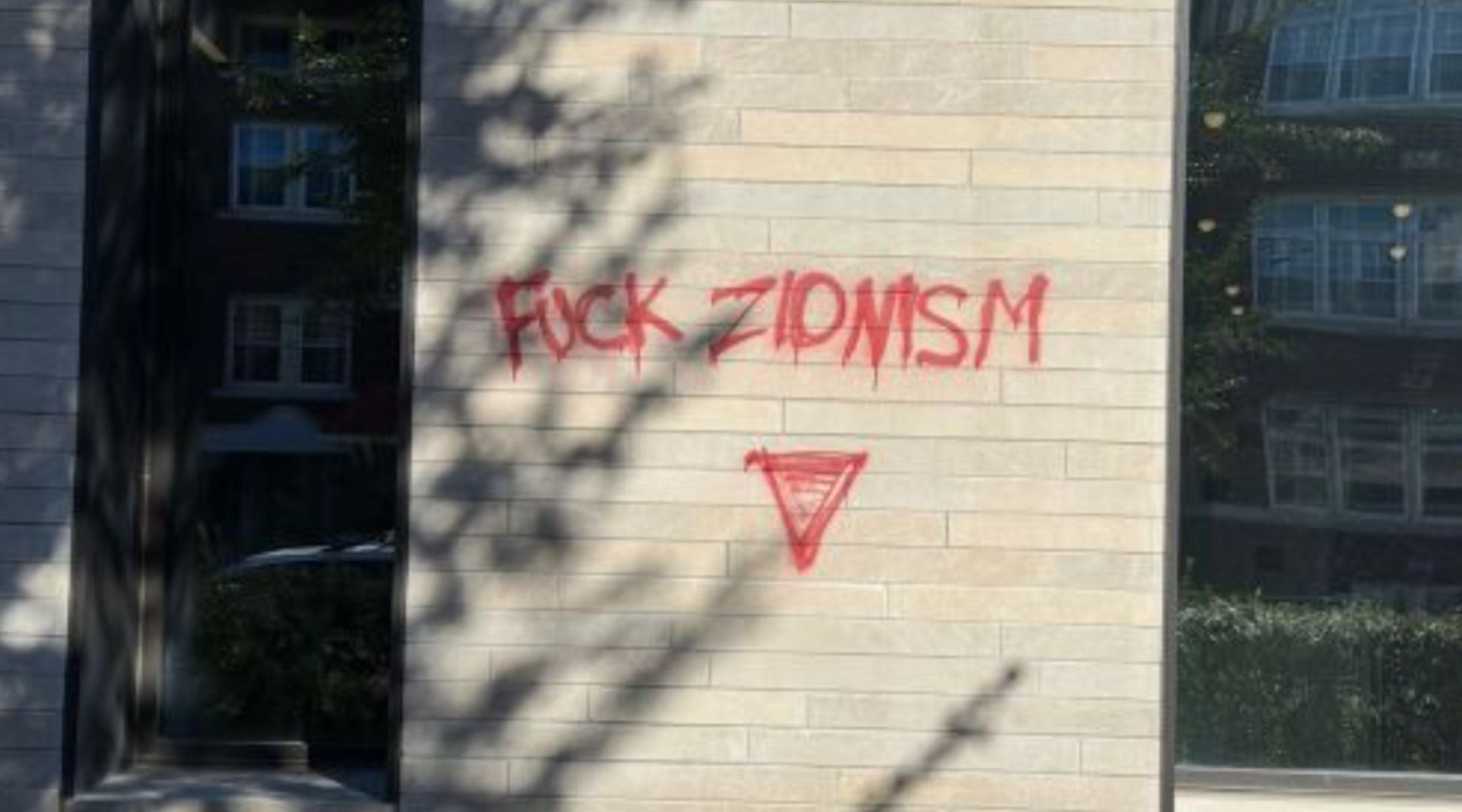
“Fuck Zionism” is spray-painted on the wall of Temple Israel. (Lonny Goldsmith/TC Jewfolk).
On the building was spray-painted “Watch out Zionists,” “Fuck Zionism,” and “Al-Aqsa Flood,” Hamas’ code name for the Oct. 7 attack. There were also 14 inverted red triangles spray-painted on the building — a symbol associated with Hamas, which has used it in videos produced by its military wing to signify Israeli targets. The symbol has appeared in other graffiti of Jewish institutions during theIsrael-Hamas war.
Zimmerman said a report has been filed with the Minneapolis Police Department and video footage has been turned over for the investigation. E-mails to the MPD seeking comment were not returned.
Steve Hunegs, the executive director of the Jewish Community Relations Council of Minnesota and the Dakotas, called the incident “harrowing.”
“It’s targeted and consciously imitating the mass terrorism of Oct. 7,” he said. “It doesn’t get much more antisemitic and violent than that, other than the actual perpetration of the horrific acts.”
Hunegs said the incident represents an escalation of anti-Israel rhetoric.
“We’re seeing that someone would take the time to, in the middle of the night on Oct. 7, to vandalize the synagogue with the most incendiary, venomous message you could possibly find,” he said. The perpetrators, Hunegs said, decided “terrorism against Jews is worthy of celebration, and [they’re] going to take that message to an iconic synagogue in the heart of Minneapolis.”
Zimmerman said that she heard from Gov. Tim Walz and Minneapolis Mayor Jacob Frey, who is Jewish and has attended services at Temple Israel. He said in a tweet that the vandalism was “a reminder that hate still tries to find a foothold” but that it would not find on in the city.
“People are reaching out and in that, you feel a connection and camaraderie and support,” Zimmerman said. “Which is very helpful, but it doesn’t take away the horror of the message. It does help to not feel so alone.”
Zimmerman said she is a proud Zionist who also wants to see an end to suffering in Gaza — something that she said whoever spray-painted the graffiti did not understand.
“If you do understand the nuance and the complicated realities of the world and see each other as human, then you don’t do this. It’s disregarding the humanity of others by promoting hate and promulgating hate,” she said. “But it’s not going to stop us from continuing to do our work and to do interfaith work and to move forward in being proud of being Jewish and teaching about Israel and making sure that we work towards peace and towards the mission of being in the city and supporting the city.”
This story originally appeared on TC Jewfolk, an independent publication covering Jewish life in Minneapolis.
—
The post Minneapolis synagogue targeted with antisemitic, pro-Hamas graffiti on Oct. 7 anniversary appeared first on Jewish Telegraphic Agency.
Uncategorized
Jewish freelance journalist Emily Wilder is detained as Israeli military intercepts Gaza aid flotilla
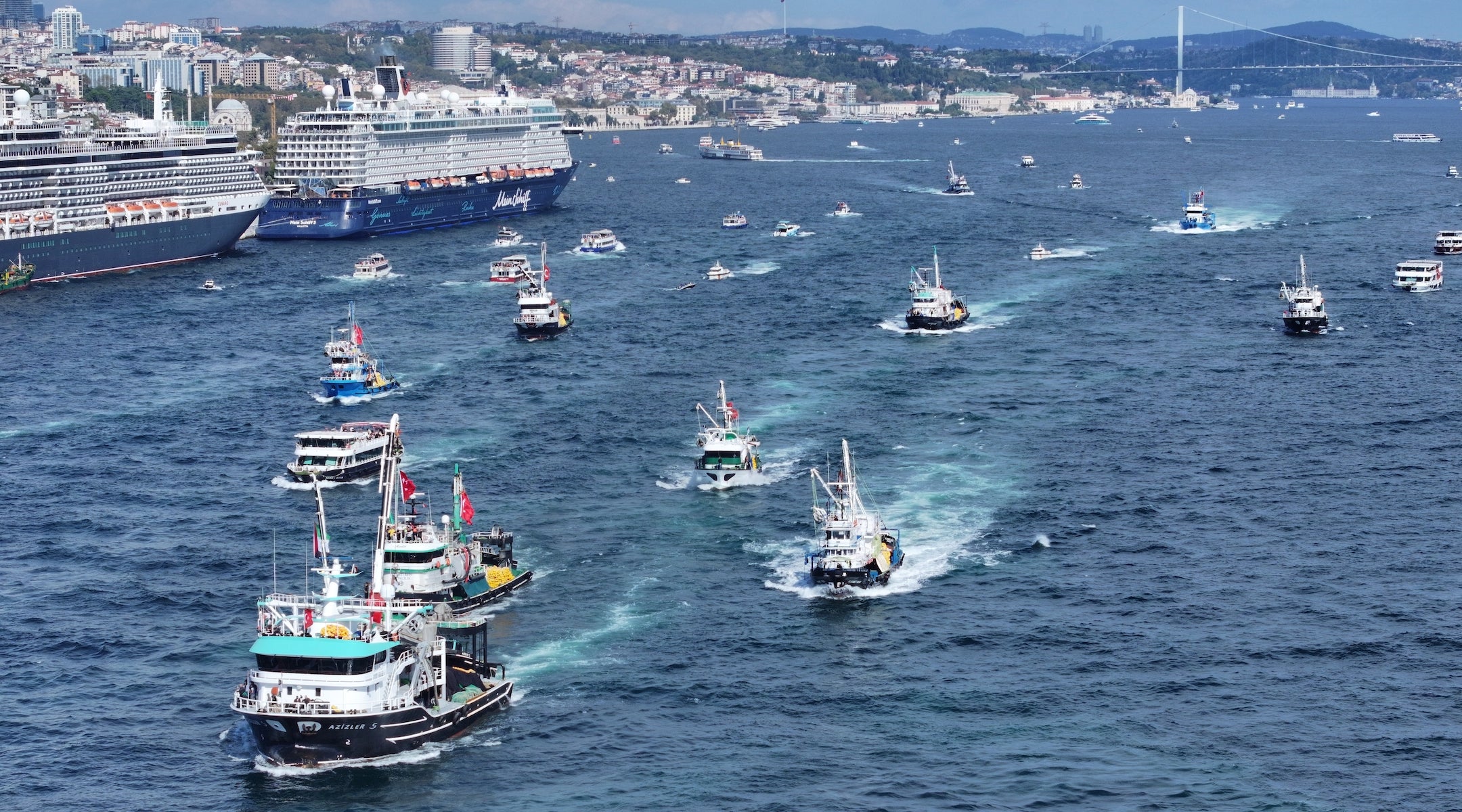
(JTA) — Jewish freelance journalist Emily Wilder, reporting for Jewish Currents, a progressive Jewish publication, was detained by the Israeli military on Monday while covering an aid flotilla bound for Gaza.
Wilder set sail from Italy last week aboard The Conscious, one of dozens of boats that aimed to reach Gaza and deliver humanitarian aid to the besieged enclave.
But that effort was cut short when Wilder, along with the other journalists and aid workers on her voyage, was intercepted by the Israeli military and detained. The military has intercepted, detained and deported activists sailing to Gaza multiple times in recent weeks.
Jewish Currents has been staunchly against the war in Gaza, calling Israel’s campaign there a genocide and advocating for the Palestinian cause. In an email to subscribers, publisher Daniel May said the publication sent Wilder on a flotilla because of the value of the reporting she could produce.
“Jewish Currents commissioned Emily’s reporting because we know that Israel’s unprecedented restrictions on journalists have facilitated the war crimes perpetrated in Gaza,” May wrote. “We also know that the flotillas are an important story in themselves.”
Wilder was a member of Jewish Voice for Peace and Students for Justice in Palestine, both anti-Zionist groups, as a student at Stanford University, from which she graduated in 2020. The next year, she was fired from the Associated Press in 2021 due to her social media posts about the Israeli-Palestinian conflict. Since then, according to her LinkedIn, she has worked as a freelancer and a human rights researcher.
Wilder was also documenting the voyage on her Instagram account, which has not posted an update since she and her crew were detained.
“Today, the @gazafreedomflotilla’s Conscience sets sail from the boot of Italy, with hopes of bringing ~70 media and medical workers across the Mediterranean to Gaza’s shores amid Israel’s blockade on international press and killing of doctors and journalists,” wrote Wilder last week in a post.
Israel’s foreign ministry blasted the flotilla participants in a post on X Tuesday.
“Another futile attempt to breach the legal naval blockade and enter a combat zone ended in nothing,” the post read. “The vessels and the passengers are transferred to an Israeli port. All the passengers are safe and in good health. The passengers are expected to be deported promptly.’
In the email, May directed readers to sign a Change.org petition calling for her release and to urge the California native’s representatives, including Democratic Sens. Adam Schiff and Alex Padilla, to advocate for her.
Last week, dozens of other boats that were part of the Global Sumud Flotilla were also intercepted, and hundreds of participants were detained and later deported, including Swedish activist Greta Thunberg who alleged that she had been “kidnapped and tortured” by the Israeli military. (Another flotilla effort including Thunberg was intercepted by the Israeli military in June.)
“My office has now confirmed that a second flotilla carrying vital humanitarian aid … has been intercepted, and nearly 145 passengers and crew detained,” wrote California Democratic Rep. Jimmy Comez in a statement. “Among the detained is my constituent Emily Wilder, a member of the press, who was reporting on the flotilla’s attempt to bring humanitarian aid to the people of Gaza.”
The post Jewish freelance journalist Emily Wilder is detained as Israeli military intercepts Gaza aid flotilla appeared first on The Forward.


